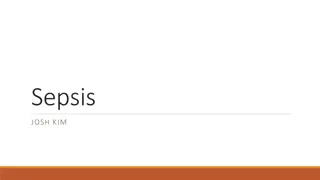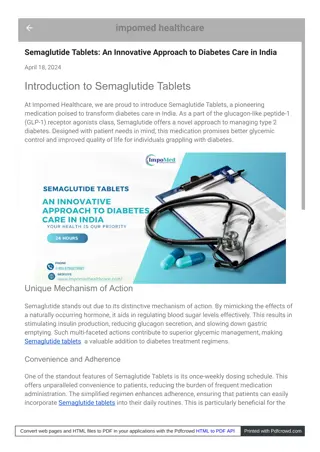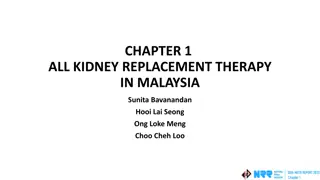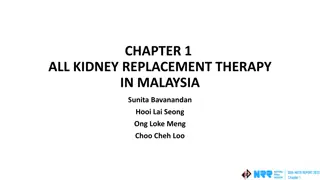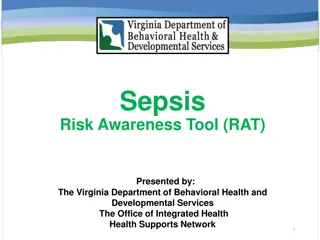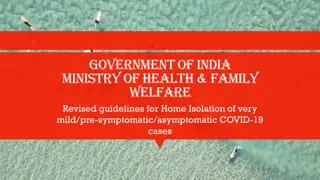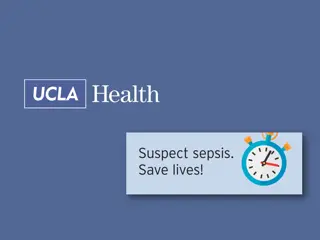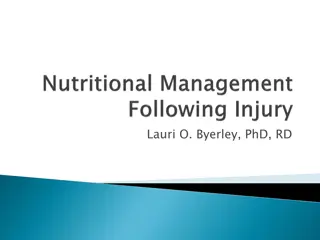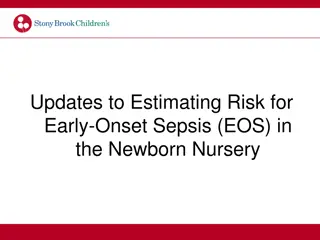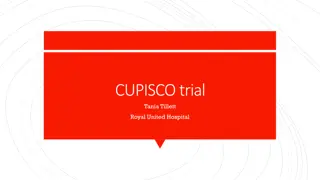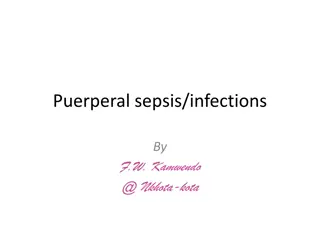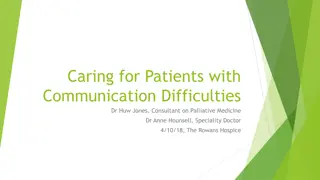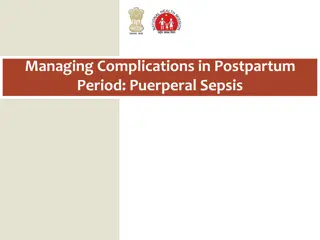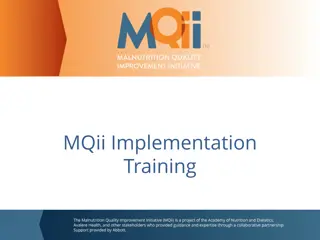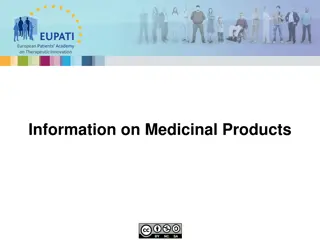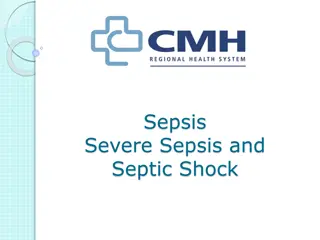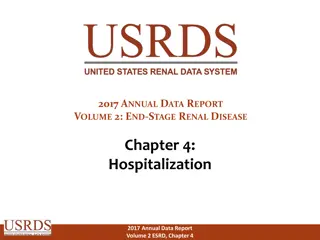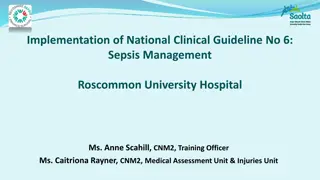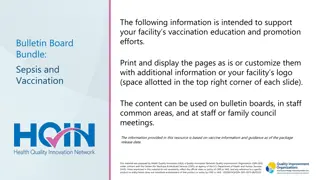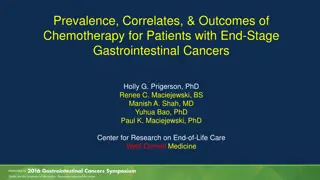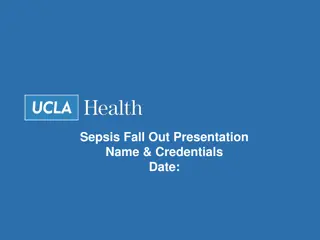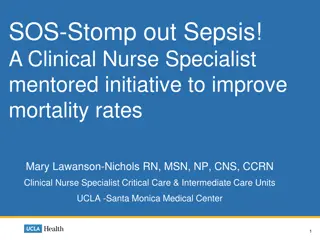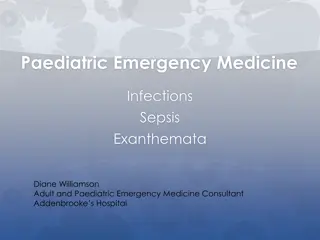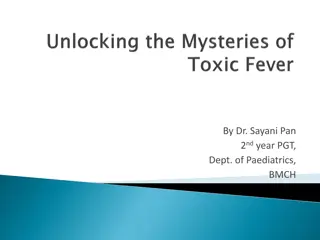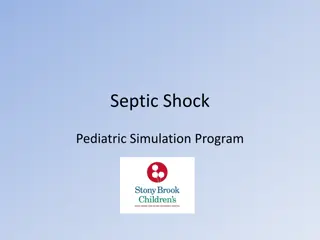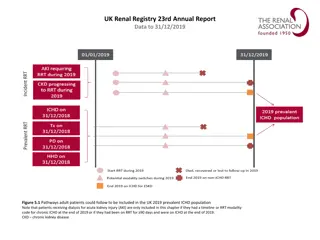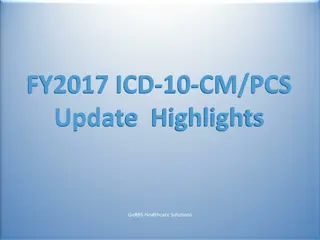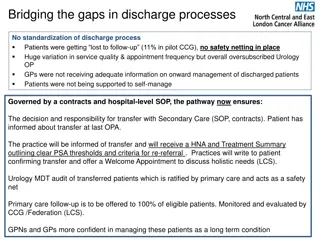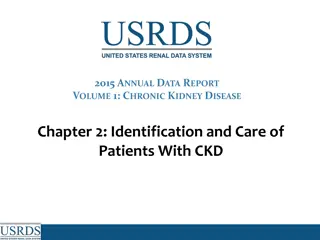PKB - Patients Know Best
PKB (Patients Know Best) is a patient-held record platform that empowers patients to access and manage their health information effectively. It enables patients to track symptoms, connect devices, share data with clinical teams, and engage in self-care. With features like communication tools, sympto
0 views • 10 slides
Understanding Sepsis: Current Management Strategies and Global Efforts
Sepsis is a life-threatening infectious illness with significant global impact. The World Sepsis Declaration of 2012 underscores the need for improved recognition, prevention, and treatment strategies to address the high burden of sepsis worldwide. Efforts are being made to enhance management guidel
4 views • 118 slides
Case Study: Sepsis Presentation and Management in Two Patients
Mrs. NP, a 55-year-old woman with a background of cirrhosis from heavy alcohol use, presented to the ED with symptoms suggestive of sepsis. Examination revealed a febrile state, elevated blood pressure, and altered mental status. Investigations were initiated to determine the cause, with differentia
2 views • 41 slides
Enhancing Pediatric Care with the Irish Paediatric Early Warning System (PEWS)
The Irish Paediatric Early Warning System (PEWS) has been updated to align with National Sepsis Guidance in May 2023. It aims to assist in recognizing and responding to deterioration in pediatric patients, emphasizing the importance of clinical judgment and individualized assessment. PEWS does not r
1 views • 41 slides
Understanding Semaglutide Tablets: Key Insights for Indian Patients
Impomed Healthcare empowers Indian diabetes patients with comprehensive guidance on the innovative Semaglutide tablets. We explain how these tablets offer the dual benefits of blood sugar control and weight management through their unique mechanism. Our insights into Semaglutide help patients make i
11 views • 3 slides
Early Vasopressors in Sepsis Clinical Trial: Improving Patient Outcomes
This UK-wide clinical trial aims to assess the effectiveness of early peripheral norepinephrine infusion in adult patients with septic shock. The study will compare the impact on mortality and other outcomes of targeting a mean arterial pressure (MAP) above 65mmHg within the first 48 hours of admiss
1 views • 9 slides
Kidney Replacement Therapy Incidence Trends in Malaysia
The data presented in this study outlines the stock and flow of new Kidney Replacement Therapy (KRT) patients in Malaysia from 2012 to 2022. It covers the incidence rates of new dialysis patients, hemodialysis (HD) patients, peritoneal dialysis (PD) patients, and transplant patients. The figures and
1 views • 12 slides
Kidney Replacement Therapy Trends in Malaysia 2012-2022
A comprehensive overview of kidney replacement therapy (KRT) trends in Malaysia from 2012 to 2022 is presented, detailing the stock and flow of new KRT incidences and ESKD patients on KRT. The data includes the number of new dialysis patients, new HD patients, new PD patients, and new transplant pat
0 views • 12 slides
Sepsis Risk Awareness Tool (RAT) Training Program Overview
The Sepsis Risk Awareness Tool (RAT) training program by The Virginia Department of Behavioral Health and Developmental Services aims to educate support coordinators, DSPs, and caregivers about the risk factors, signs, and symptoms of sepsis. It covers definitions, risk factors, signs, symptoms, dia
3 views • 22 slides
Revised Guidelines for Home Isolation of COVID-19 Cases in India
The Ministry of Health & Family Welfare in India has issued revised guidelines for home isolation of very mild/pre-symptomatic/asymptomatic COVID-19 cases. Patients eligible for home isolation must have the necessary facility for self-isolation. Special considerations apply to elderly patients and t
2 views • 16 slides
National Audit Results for Severe Sepsis and Septic Shock 2016/17
This presentation outlines the national results of a clinical audit conducted in 2016/17 regarding the management of severe sepsis and septic shock in Emergency Departments (EDs). The audit objectives include benchmarking current performance, facilitating national and peer comparisons, identifying a
0 views • 25 slides
Collaborating to Combat Sepsis: Role of Respiratory Therapists
Sepsis is a critical condition involving infection and inflammation, where the body's response causes widespread symptoms. Learn about the continuum of sepsis, its pathophysiology, and respiratory warning signs. Respiratory therapists play a crucial role in identifying and managing sepsis, with stat
1 views • 14 slides
Implementation of UCLA Sepsis BPA Functionality & Careplan
The UCLA Sepsis Best Practice Alert (BPA) system aids in creating timely and effective care plans for patients diagnosed with sepsis. This comprehensive guide covers the activation triggers, BPA location, creation process, and elements of the Sepsis Careplan, emphasizing the importance of early inte
1 views • 16 slides
Importance of Nutrition in Patient Healing and Recovery
Gain insight into the critical role of nutrition in aiding patients in their recovery from injuries and enhancing their physical well-being post-injury. Explore the phases of injury, the physiological and metabolic impacts of each phase, and the corresponding nutritional support strategies. Delve in
1 views • 49 slides
Understanding Early-Onset Sepsis (EOS) Risk Factors and Management in Newborns
Neonatal Early-Onset Sepsis (EOS) is a rare but life-threatening condition primarily caused by Group B Streptococcus (GBS) or Escherichia coli. Recognizing risk factors such as maternal age, intrapartum fever, GBS colonization, and certain neonatal characteristics is crucial for timely evaluation an
0 views • 26 slides
Molecularly-Guided Therapy vs Platinum Chemotherapy in CUP Patients
This trial aims to compare the efficacy and safety of molecularly-guided therapy or cancer immunotherapy based on genomic profiling with platinum-based chemotherapy in patients with cancer of unknown primary site. The study design includes multiple treatment regimens guided by genomic profiles, with
4 views • 9 slides
Improving Sepsis Care Pathways: Rob's Story Highlights Areas for Enhancement
Rob's journey through a sub-optimal sepsis care pathway sheds light on crucial areas for improvement, such as insufficient education, poor communication, tracking issues, and serious implications leading to family distress and legal challenges. The story emphasizes the importance of timely and effec
1 views • 11 slides
Prevention and Management of Puerperal Sepsis and Infections
Puerperal sepsis and infections are serious conditions affecting women postpartum. Puerperal sepsis is characterized by specific symptoms, while puerperal infections are more general. Prevention includes antenatal care, strict intrapartum hygiene practices, and timely interventions. By following gui
2 views • 8 slides
Communicating with Patients with Cognitive Impairment and Other Communication Difficulties
This presentation highlights the causes of communication difficulties in patients, focusing on cognitive impairment, sensory impairments, and language barriers. It emphasizes the challenges of caring for these patients, including assessing pain and managing symptoms effectively. Practical strategies
0 views • 27 slides
Managing Complications in Postpartum Period: Puerperal Sepsis Overview
Puerperal sepsis, a leading cause of maternal death, can be prevented through hygiene practices and early identification. Learn about the risk factors, diagnosis, and prevention strategies for maternal sepsis in the postpartum period.
3 views • 9 slides
Implementing MQii for Patient-Centered Care
Implementing the Malnutrition Quality Improvement Initiative (MQii) involves training project teams, understanding clinical workflows, and engaging patients in their care. Multidisciplinary project and care teams play essential roles in effective implementation, with patients and family caregivers c
5 views • 33 slides
European Patients Academy on Therapeutic Innovation: Information on Medicinal Products
Accurate and up-to-date information on medicinal products is crucial for patients and healthcare professionals. The European Patients Academy on Therapeutic Innovation provides insights into topics such as package leaflets, labelling requirements, and information to be provided according to the Dire
0 views • 25 slides
Biomarker-Guided Antibiotic Duration in Sepsis Patients
This research focuses on evaluating the safety and efficacy of a biomarker-guided approach to determine the duration of antibiotic treatment in hospitalized adult patients with sepsis. The study involves a multi-centre randomized controlled trial to assess if a treatment protocol based on monitoring
0 views • 53 slides
Understanding Sepsis and Its Impact on Patient Care
Sepsis is a life-threatening condition resulting from the body's response to an infection, leading to shock, multiple organ failure, and potentially death if left untreated. Recognizing and treating sepsis promptly is crucial, as it has a high mortality rate and can have a significant impact on pati
1 views • 21 slides
Understanding and Preventing Sepsis: Vital Information for Caregivers
Sepsis is a life-threatening condition caused by the body's response to infection. Learn about the symptoms, prevention strategies, and how to recognize and respond to sepsis in a healthcare setting. The importance of reporting vital signs accurately and understanding patient behavior is also highli
1 views • 9 slides
Hospitalization Trends for End-Stage Renal Disease Patients 2006-2015
Analysis of adjusted hospitalization rates for End-Stage Renal Disease (ESRD) patients by treatment modality from 2006 to 2015, indicating differences in rates based on age, sex, race, and primary cause of kidney failure. The data covers all-cause and cause-specific hospitalization rates for ESRD pa
0 views • 21 slides
Implementation of Sepsis Management Guidelines at Roscommon University Hospital
Sepsis, a life-threatening condition, necessitates timely management for improved outcomes. Roscommon University Hospital implemented the Sepsis Screening Program in 2016 with the objective of standardizing practices, educating teams, and assessing outcomes. The initiative includes training, tool im
1 views • 18 slides
Importance of Vaccinations in Sepsis Prevention
Sepsis is a life-threatening response to infection that can lead to organ failure and death. Infection prevention through vaccinations is crucial to combat sepsis. Best practices include obtaining vaccination consent, offering education, and co-administering vaccines to older adults. Accessing vacci
1 views • 8 slides
Contrasting Pathways in Sepsis Care: Rob's Journey
Rob's story illustrates the stark contrast between sub-optimal and optimal pathways in managing sepsis. Delayed recognition and treatment in the sub-optimal pathway led to severe complications, whereas timely intervention in the optimal pathway resulted in improved outcomes. The importance of early
1 views • 7 slides
Chemotherapy Utilization in End-Stage Gastrointestinal Cancer Patients
This presentation explores the prevalence, correlates, and outcomes of chemotherapy use in patients with end-stage gastrointestinal cancers. Data is presented on the frequency of chemotherapy administration, correlates, harms, and benefits in patients in their final months of life. Insights from stu
0 views • 21 slides
Analysis of Kidney Transplant Trends in End-Stage Renal Disease Patients (1996-2013)
This report delves into the trends surrounding kidney transplants in end-stage renal disease (ESRD) patients from 1996 to 2013. It looks at the percentage of dialysis patients wait-listed, unadjusted kidney transplant rates, number of patients wait-listed for kidney transplants, transplant counts, p
0 views • 33 slides
Sepsis Fallout Presentation - Managing Severe Sepsis and Septic Shock
This presentation template guides healthcare professionals on effectively managing severe sepsis and septic shock cases, emphasizing prompt recognition and appropriate interventions. It includes sections on patient background, sepsis criteria, treatment protocols, and debriefing discussions for cont
0 views • 7 slides
Improving Mortality Rates in Sepsis Patients: A Clinical Nurse Specialist Initiative
Clinical Nurse Specialist, Mary Lawanson-Nichols, initiated a program at UCLA-Santa Monica Medical Center to reduce mortality rates in sepsis patients. By focusing on mentoring skills, leadership development for staff nurses, and examining influences on mortality, the program aims to make a signific
0 views • 24 slides
Paediatric Emergency Medicine Overview: Infections, Sepsis, Exanthemata, and Warning Signs
Paediatric emergency medicine involves assessing and managing various conditions in children, such as infections, sepsis, and exanthemata. This overview covers the evaluation of febrile children, warning signs indicating potential serious illness, and the importance of thorough examination and asses
0 views • 48 slides
Case Study: Infant with Persistent Fever and Cry
Aditi Malakar, a 2-month-old female infant, presented with a remittent fever persisting for 9 days unresponsive to antipyretics, along with persistent crying and decreased feeding for the last 2 days. She was referred to the hospital after being diagnosed with sepsis elsewhere. Aditi had a history o
0 views • 31 slides
Management Strategies for Pediatric Septic Shock Simulation Program
This content provides information on the management of sepsis, including recognition, supportive care, source control, antibiotics, and specific therapies. It emphasizes the importance of initial resuscitation goals, strategies involving fluid resuscitation, inotropic support, and timely administrat
0 views • 12 slides
UK Renal Registry 23rd Annual Report 2019 Data Analysis
The UK Renal Registry's 23rd Annual Report provides comprehensive data on the pathways followed by adult patients to be included in the UK 2019 prevalent ICHD population. The report includes figures on percentage of patients with URR >65%, median URR achieved, changes in URR by sex between 2009 and
0 views • 19 slides
Updates and Highlights in FY2017 ICD-10-CM/PCS
In the FY2017 update of ICD-10-CM/PCS, significant changes have been made with new codes, updates, and deletions affecting coding diagnoses. The update includes coding highlights related to various conditions like bacteriuria, sepsis, pre-diabetes, and Zika virus. The Third International Consensus D
0 views • 30 slides
Improving Discharge Processes for Urology Patients
Addressing gaps in discharge processes for urology patients led to the implementation of a standardized pathway ensuring proper communication, transfer protocols, and follow-up strategies. The pathway includes informed patient transfers, detailed communication with primary care, holistic needs asses
0 views • 5 slides
Chronic Kidney Disease: Prevalence and Comorbid Conditions Among Medicare Patients
The data report presents information on the identification, care, and prevalence of Chronic Kidney Disease (CKD) among Medicare patients aged 65 and above in 2013. It includes tables showing the ICD-9-CM codes for CKD stages, prevalence of coded comorbid conditions (CKD, CVD, DM), demographic charac
0 views • 15 slides


